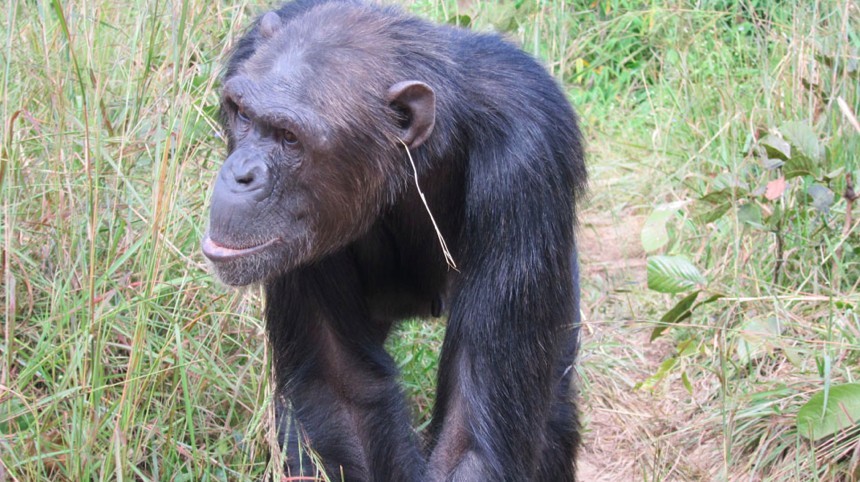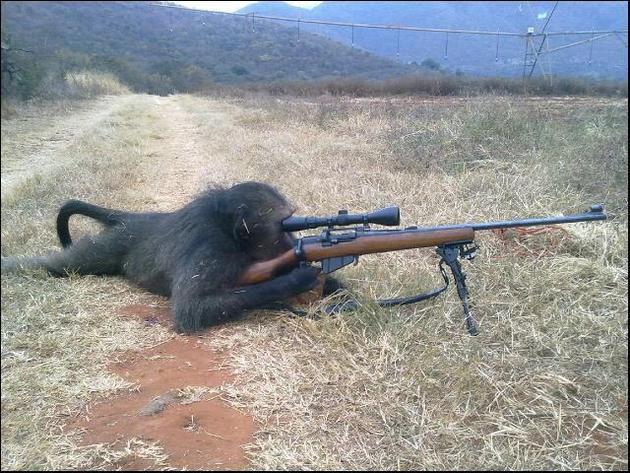It looks like you're using an Ad Blocker.
Please white-list or disable AboveTopSecret.com in your ad-blocking tool.
Thank you.
Some features of ATS will be disabled while you continue to use an ad-blocker.
For The 1st Time, Chimps Are Making A Fashion Statement - Sticking Blades Of Grass In Their Ha
page: 1share:
Although I was aware that in many ways animals mirror our own behavior as a species. I had no idea that they may have a concept of fashion or may be
developing one.
www.thedodo.com...
Below is a picture of a lovely chimp sporting the new earring...

We have a lot to learn about such lovely creatures. Personally I would like to see them given more protection rights both in the wild and captivity. These are our cousins. Not so far removed..
kind regards
purp....
It’s a trend that’s taken a troop of chimpanzees by storm: a blade of grass dangling from an ear. The "grass-in-ear behavior," as scientists have termed it, seems to be one of the first times that chimpanzees have created a tradition with no discernible purpose -- a primate fashion statement, in other words.
www.thedodo.com...
To figure out if this was really a tradition, and not just chimpanzees sticking grass in their ears at random, van Leeuwen and his colleagues spent a year observing four chimp groups in Chimfunshi Wildlife Orphanage Trust, a sanctuary in Zambia. Only one troop performed the grass-in-ear behavior, although all of the chimps lived in the same grassy territory. There’s no genetic or ecological factors, the scientists believe, that would account for this behavior -- only culture.
Lydia Luncz, a primatologist at the Max Planck Institute in Leipzig, Germany, who was not involved with the research, agrees. This study shows how the chimpanzees who learned to put grass in their ears did so through the “natural transmission” of new behavior, she says.
Below is a picture of a lovely chimp sporting the new earring...

We have a lot to learn about such lovely creatures. Personally I would like to see them given more protection rights both in the wild and captivity. These are our cousins. Not so far removed..
kind regards
purp....
edit on 28-6-2014 by purplemer because: (no reason given)
I can just see next years Vogue
The more we look into them the more we can see ourselves in our evolutionary cousins .
Love em.
Cool find.
The more we look into them the more we can see ourselves in our evolutionary cousins .
Love em.
Cool find.
a reply to: purplemer
I like stories like these for several reasons. They show that, yeah, humans are super-special, but not as super as we like to think. When we strut around as the one special species on Earth, we need to look how close we are to the other primates.
If we have souls, what do chimps have? Is it soulful to ornament our human bodies? What thoughts make them do the same? If we don't have souls and we're strictly speaking about sentience, what makes our sentience more valuable then theirs? If they have it, and crows and elephants have it, what else has it?
From the perspective of anthropology, when we look at the chimp and her grass ear-piece, we're actually seeing one of the profound steps that our own ancestors took. It doesn't look like much does it? We wouldn't even have internet without one of our hairy ancestors having the idea of fashion, culture and hitting other things with rocks and sticks.
That single piece of grass shows artistic conceptualisation, pre-planning, tool-use and culture. That makes it one of the most awesome grass blades in a couple of million years.
I like stories like these for several reasons. They show that, yeah, humans are super-special, but not as super as we like to think. When we strut around as the one special species on Earth, we need to look how close we are to the other primates.
If we have souls, what do chimps have? Is it soulful to ornament our human bodies? What thoughts make them do the same? If we don't have souls and we're strictly speaking about sentience, what makes our sentience more valuable then theirs? If they have it, and crows and elephants have it, what else has it?
From the perspective of anthropology, when we look at the chimp and her grass ear-piece, we're actually seeing one of the profound steps that our own ancestors took. It doesn't look like much does it? We wouldn't even have internet without one of our hairy ancestors having the idea of fashion, culture and hitting other things with rocks and sticks.
That single piece of grass shows artistic conceptualisation, pre-planning, tool-use and culture. That makes it one of the most awesome grass blades in a couple of million years.
edit on 28-6-2014 by Kandinsky because: concept to conceptualisation...
a reply to: Kandinsky
I've often wondered. There's no denying they have emotions and am particularly struck by displays of compassion and empathy.
And our ability to talk. Funny how even humans seem to lose that talent without an awareness of it's power or by exercising it.
If we have souls, what do chimps have?
I've often wondered. There's no denying they have emotions and am particularly struck by displays of compassion and empathy.
We wouldn't even have internet without one of our hairy ancestors having the idea of fashion, culture and hitting other things with rocks and sticks.
And our ability to talk. Funny how even humans seem to lose that talent without an awareness of it's power or by exercising it.
a reply to: Snarl
Hiya Snarl, on my more speculative days, I wonder if we'll see a form of Abolitionist movement in the decades to come? If people start to accept that chimps are our cousins in more ways than DNA strings, where will it leave us?
Sometimes we find ourselves living in 'interesting times' and we've been lucky to see developments in chimp culture in recent years. I'm thinking of the expansion of tool use as well as this grass-in-ear fashion. Whatever next?
I've often wondered. There's no denying they have emotions and am particularly struck by displays of compassion and empathy.
Hiya Snarl, on my more speculative days, I wonder if we'll see a form of Abolitionist movement in the decades to come? If people start to accept that chimps are our cousins in more ways than DNA strings, where will it leave us?
Sometimes we find ourselves living in 'interesting times' and we've been lucky to see developments in chimp culture in recent years. I'm thinking of the expansion of tool use as well as this grass-in-ear fashion. Whatever next?
It is more likely to be Chimps copying human behaviour than simply coming out on their own.
This is not a group of Chimps in the wild, it is a group in a shelter with humans around.
They see, they copy. Our own human children do the same thing!
P
This is not a group of Chimps in the wild, it is a group in a shelter with humans around.
They see, they copy. Our own human children do the same thing!
P
a reply to: pheonix358
It still reflects a change in the culture of the chimpanzees. It isn't something that's been reported/recorded anywhere else so the conscious decision for these chimps, not others, to wear a grass stalk distinguishes them from others.
Furthermore, having a piece of grass sticking out of our ears isn't a recognisable part of human culture. For your idea to be tested, we'd want to see if there's evidence that the chimps have been exposed to people with grass in their ears.
It still reflects a change in the culture of the chimpanzees. It isn't something that's been reported/recorded anywhere else so the conscious decision for these chimps, not others, to wear a grass stalk distinguishes them from others.
Furthermore, having a piece of grass sticking out of our ears isn't a recognisable part of human culture. For your idea to be tested, we'd want to see if there's evidence that the chimps have been exposed to people with grass in their ears.
I don't think much of these scientists. One look at the first picture and I suspect it's to help them tell wind direction - the wind blows on the
grass and they feel it in their ear. It's probably a lot more sensitive than their fur, allowing them to sense minor changes in the breeze. This
would let them know what direction to sneak up on prey, and which way to run if they are being hunted (wind carries scent).
a reply to: Kandinsky
Culture dictates behavior (even if originally behavior gave birth to culture) and if that behavior does not follow through in some instances, causing outliers, then usually the outlier is punished for not submitting to the established standards.
We can examine the legitimacy of this apparently new development by noting whether the outliers of that form of "dress" (those without the blade of grass), are treated differently from the well-dressed chimps. There are always consequences in mono-cultures, pro and con, that are easy to determine.
Culture dictates behavior (even if originally behavior gave birth to culture) and if that behavior does not follow through in some instances, causing outliers, then usually the outlier is punished for not submitting to the established standards.
We can examine the legitimacy of this apparently new development by noting whether the outliers of that form of "dress" (those without the blade of grass), are treated differently from the well-dressed chimps. There are always consequences in mono-cultures, pro and con, that are easy to determine.
edit on 28-6-2014 by Aliensun because: cut a word How many times must this "edit" feature appear?
a reply to: peskyhumans
How do you tell which way the wind is blowing? You do it without a piece of grass, right?
These chimps exist in a sanctuary where there are no predators and food is provided. Sure, your sophisticated concept of a grass windsock might be used by these chimps, but the simpler explanation is that we're seeing culture in play. If you are right about the wind-detector, that would also be evidence of culture.
a reply to: Aliensun
I'd like to get a look at the full paper to get more details. As it stands, the paper has been well-received and taken as evidence that it's an aspect of culture they're displaying.
Here's part of the abstract >>
One look at the first picture and I suspect it's to help them tell wind direction - the wind blows on the grass and they feel it in their ear. It's probably a lot more sensitive than their fur, allowing them to sense minor changes in the breeze.
How do you tell which way the wind is blowing? You do it without a piece of grass, right?
These chimps exist in a sanctuary where there are no predators and food is provided. Sure, your sophisticated concept of a grass windsock might be used by these chimps, but the simpler explanation is that we're seeing culture in play. If you are right about the wind-detector, that would also be evidence of culture.
Chimpanzees Have Discovered Dumb Fashion Trends
To figure out if this was really a tradition, and not just chimpanzees sticking grass in their ears at random, van Leeuwen and his colleagues spent a year observing four chimp groups in Chimfunshi Wildlife Orphanage Trust, a sanctuary in Zambia. Only one troop performed the grass-in-ear behavior, although all of the chimps lived in the same grassy territory. There’s no genetic or ecological factors, the scientists believe, that would account for this behavior — only culture.
a reply to: Aliensun
I'd like to get a look at the full paper to get more details. As it stands, the paper has been well-received and taken as evidence that it's an aspect of culture they're displaying.
Here's part of the abstract >>
A group-specific arbitrary tradition in chimpanzees (Pan troglodytes)
While the rigour of experimental studies is helpful to investigate social learning mechanisms, documentation of naturally occurring traditions is necessary to understand the relevance of social learning in the real lives of animals. In this study, we report on chimpanzees spontaneously copying a seemingly non-adaptive behaviour (“grass-in-ear behaviour”). The behaviour entailed chimpanzees selecting a stiff, straw-like blade of grass, inserting the grass into one of their own ears, adjusting the position, and then leaving it in their ear during subsequent activities. Using a daily focal follow procedure, over the course of 1 year, we observed 8 (out of 12) group members engaging in this peculiar behaviour. Importantly, in the three neighbouring groups of chimpanzees (n = 82), this behaviour was only observed once, indicating that ecological factors were not determiners of the prevalence of this behaviour. These observations show that chimpanzees have a tendency to copy each other’s behaviour, even when the adaptive value of the behaviour is presumably absent.
edit on 28-6-2014 by Kandinsky because: (no reason given)
When the humans have wiped each other out the monkeys will rule, evolve into humans then wipe each other out and the cycle will continue.
a reply to: peskyhumans
I do wonder too if it is being used for a tool still and that we just cannot see what it is... But I would give the scientists some credence they have been studying them for four years....
purp...
I do wonder too if it is being used for a tool still and that we just cannot see what it is... But I would give the scientists some credence they have been studying them for four years....
purp...
originally posted by: purplemer
a reply to: peskyhumans
I do wonder too if it is being used for a tool still and that we just cannot see what it is... But I would give the scientists some credence they have been studying them for four years....
purp...
I wonder if one the researchers who was observing them was wearing long earrings? They could have picked up the idea from there.
new topics
-
Man Stabbed or Cardiac arrest on Westminster Bridge, London, UK
Mainstream News: 1 hours ago -
A fix for the Trans players in sports
Social Issues and Civil Unrest: 2 hours ago -
Petition Calling for General Election at 564,016 and rising Fast
Political Issues: 5 hours ago
top topics
-
Petition Calling for General Election at 564,016 and rising Fast
Political Issues: 5 hours ago, 11 flags -
France gives Ukraine license to fire long-range missiles at Russia
World War Three: 17 hours ago, 9 flags -
Rep. Alexandria O. Cortez Says Forcing People to Use The Correct Bathroom is Dangerous.
US Political Madness: 12 hours ago, 7 flags -
A fix for the Trans players in sports
Social Issues and Civil Unrest: 2 hours ago, 7 flags -
Ok this is some BS now WTH
Rant: 15 hours ago, 5 flags -
Cooperation zones
World War Three: 13 hours ago, 4 flags -
Man Stabbed or Cardiac arrest on Westminster Bridge, London, UK
Mainstream News: 1 hours ago, 1 flags
active topics
-
Results of the use of the Oreshnik missile system in Dnepropetrovsk
World War Three • 187 • : Imhere -
Ok this is some BS now WTH
Rant • 11 • : watchitburn -
Petition Calling for General Election at 564,016 and rising Fast
Political Issues • 32 • : angelchemuel -
France gives Ukraine license to fire long-range missiles at Russia
World War Three • 29 • : BedevereTheWise -
Man Stabbed or Cardiac arrest on Westminster Bridge, London, UK
Mainstream News • 2 • : onestonemonkey -
Cooperation zones
World War Three • 16 • : KnowItAllKnowNothin -
International Criminal Court Issues Arrest Warrant For Netanyahu
Mainstream News • 46 • : JJproductions -
-@TH3WH17ERABB17- -Q- ---TIME TO SHOW THE WORLD--- -Part- --44--
Dissecting Disinformation • 3367 • : Thoughtful3 -
Rep. Alexandria O. Cortez Says Forcing People to Use The Correct Bathroom is Dangerous.
US Political Madness • 28 • : WeMustCare -
A fix for the Trans players in sports
Social Issues and Civil Unrest • 9 • : Xtrozero





